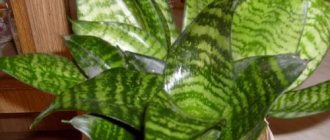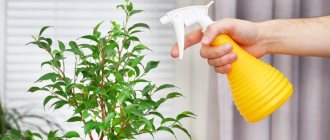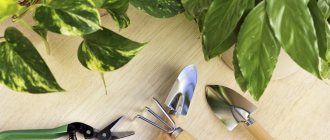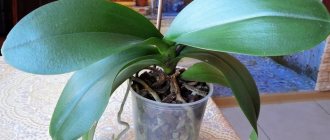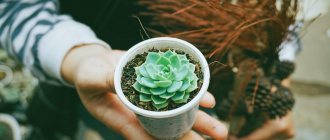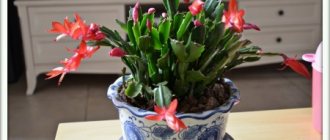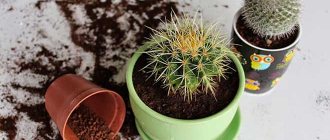When is the best time to replant plants?
In order to find out when to replant indoor flowers and whether there is a need for it, you should look at a couple of external factors that may appear if the plant already requires replanting.
The process of replanting a houseplant
You should pay attention to:
- The soil dries out too quickly after watering. This indicates that the root system has grown very much and a larger container is needed.
- Drainage holes - If roots are pushing out through these, this is a sign that a larger container is needed.
- Lack of growth or its strong slowdown.
- The appearance of diseases in the plant.
- Deterioration of the quality of the soil in the pot.
- Poor state of the root system.
It is important to remember that it is best to replant plants at certain time periods, otherwise there is a risk of harming the flower.
For example, it is worth changing the soil of recently purchased plants, but not immediately after purchase, but after a couple of weeks or a month. Because the plant has already experienced severe stress and climate change.
Attention! When purchasing a plant, it is necessary to allow the representative of the flora to adapt a little to its surrounding conditions and only then replant.
When can you replant indoor flowers according to the seasons?
As for the appropriate time of year for replanting, representatives of botanical sciences recommend replanting plants in mid-spring, that is, at the end of March, in April or at the beginning of May. Winter is the most unfavorable time of year for soil renewal. Under no circumstances should you replant flowers in January or December; in February the procedure is carried out in exceptional cases.
Also, you should not renew the soil if the plant begins to bloom (as a rule, this happens in the summer, in June or July), it is better to postpone this matter until later.
Experts advise adhering to a certain plant replanting cycle, as follows:
- Long-lived flowers should be replanted at least once every 2 years.
- Indoor plants are quite unpretentious and require replanting every 3 years.
- Well, cacti and their brothers can be in the same container for more than 5 years.
To fully comply with all the nuances, you can also resort to the lunar calendar. After all, plants are very whimsical creatures and perceive any external influences.
The lunar calendar for May 2022 will tell you favorable days for transplants
Which moon should I transplant to?
It has long been known that hair and nails grow better, and a patient who has undergone surgery during the growth phase of the Moon recovers faster. So flowers, like any other living organism, are very sensitive to the influence of the night light. During this phase, metabolic processes accelerate and juices quickly distribute nutrients throughout the plant.
If you plant or replant flowers during this period, they will quickly take root, be strong, healthy and grow rapidly.
During the new moon phase, it is better not to carry out any work with plants other than watering and loosening the soil. On the waning Moon in the fertile signs of Taurus, Pisces and Cancer, you can transplant plants; they will take root successfully.
Favorable days in June 2022
So, for example, in June from 14 to 27 - the time of the waxing moon and these days will be favorable for transplantation; it should not be done on other days.
In the video below, the florist shows how to properly replant different plants - from coffee trees to succulents, using the usual method and transfer, what pots and what soil to use for flowers:
How to choose the right pot for replanting
Pests of indoor plants and diseases of indoor flowers
On the modern gardening market there is simply a huge variety of varieties of pots for every taste and color, of all materials and shapes.
When choosing a new pot for a plant, you need to adhere to the basic rules:
- The new container should be slightly larger than the previous pot, about 2-3 cm. You should not give the plant too much free space, otherwise it will direct its forces to fill the space with roots, and the shoots will fade into the background.
- It is best to choose pots of light shades for plants, otherwise the flower may heat up too much in the sun.
Replanting is necessarily accompanied by disinfection of the pot.
Ceramics or plastic
Ceramic containers are famous for the fact that they allow air to pass through better and absorb moisture; their advantage is that they do not suffer from rapid freezing or heating. But the downside of such containers is that they are very fragile and quite expensive. Before planting a plant in a clay pot, it is best to moisten the walls of the container with water, because clay, as mentioned above, absorbs moisture very well.
Plastic plant pots
Plastic pots are famous for the fact that they are very light, but at the same time durable. At the same time, they do not absorb moisture and it becomes much easier to fill the plant with water. In general, plastic is a cheaper material than ceramic. In fact, it also looks cheap, which turns off many.
For reference! Both types of pots perform well in operation and there is no clear answer as to which one to choose. Each flower owner must decide for himself.
When should the procedure not be performed?
Planned replanting is not recommended in autumn and winter. The plant is in a dormant period, and the procedure can cause irreparable damage to it.
The procedure should be postponed in the following situations:
- immediately after purchase;
- during flowering;
- in case of disease or pest attack.
Bloom
Flowering for many species is the main process for procreation. In place of the flowers, fruits or seed pods are subsequently formed. The formation of flower stalks and buds requires large energy expenditures from the plant.
Until the end of flowering, all the plant’s forces are directed towards this process. Transplantation at this time depresses the already weakened specimen, which can lead to its death.
Infection
If you suspect a disease or pest infestation, it is not recommended to replant the plant. Signs of infection may include:
- yellow, curled leaves;
- dots and spots of different colors on the foliage;
- white sticky coating;
- holes or holes in leaves;
- web;
- pests on the trunk and lower parts of the foliage.
All this signals that the flower is sick and is not ready for any shocks.
Reference! The exception is infection or colonization of the root system and substrate by insects. They are the reason for an emergency transplant.
Preparation of drainage and soil mixture
A good soil mixture is the key to successful and healthy growth of indoor plants. The type of soil mixed depends on the specific plant for which it is intended.
Classic earth mixture
Automatic watering for indoor plants - do it yourself
For many plants, a classic soil mixture is suitable. The so-called “mix” of leaf soil or humus, garden soil, peat and river sand. All “ingredients” are mixed in equal quantities to each other, that is, 25 percent each.
If problems arise with river sand, you can easily replace it with perlite. Botanists recommend adding a little expanded clay to the resulting soil, after which everything needs to be mixed. This soil is suitable for any ficus and other indoor plants.
Soil mixture for ferns
The soil for ferns differs from the classic one in that it must have an acidic environment.
It usually consists of leaf soil (1/4 of the total volume) and humus (1/4). The remaining 50 percent is covered by heather soil. To all this you need to add a little hydrogel so that the moisture does not stagnate.
Earth mixture for succulents
A characteristic feature of such soil is that the moisture inside it should not stagnate. Succulents are very sensitive to soil and therefore require great care when composing.
River sand will take up about 1/3 of the entire mixture, the other third will be taken by compost, and finally, the remaining part is divided in half between perlite and peat.
Drainage
Properly designed drainage during transplantation is the key to good flower growth; there is nothing complicated about it.
Attention! Typically, drainage is poured in a layer of 1 to 3 centimeters, at the very bottom of the pot.
It is best to use pebbles, gravel or expanded clay as drainage, and the whole thing is seasoned with vermiculite and agroperlite for better moisture transmission through the soil.
Drainage for indoor plants
Soil preparation
It is better to purchase soil mixture for replanting in a store, since the optimal composition for a specific type of flower is selected there. If garden soil is used, it must be mixed with sand, ash and fertilizer. Ash is a natural fertilizer that is suitable for all flowers.
It is advisable to dilute acidic soils with potash fertilizers: potassium sulfate, potassium nitrate, potassium magnesium. You can check the degree of acidity at home: pour vinegar essence onto a handful of soil. If there is no reaction, the acidity is increased, the alkaline soil will foam slightly.
The prepared soil is calcined over fire (this can be done on the stove or in the oven). Sterilization is performed one hour at a time over several days. The soil mixture should have average moisture and not stick together into a dense lump when compressed. Too dense soil can be “lightened” by mixing it with peat. It is advisable to use the mixture for transplanting flowers within a week after preparation.
Soil for indoor flowers when transplanting
How to transplant flowers at home correctly
How often do you need to water indoor plants?
In principle, replanting a plant is easy, but not everyone can do it correctly, taking into account all the factors. The land plays the biggest role in this matter. After all, it depends on it whether the flower will bloom and smell fragrant, or whether it will begin to hurt or die.
Removing a plant from a pot
To remove a flower from a pot, you need to make sure that the earthen ball is moist and viscous. This will make it easiest to remove the plant from the pot.
To pull out a flower, you need to pass the crown of the plant between your fingers and, holding the soil, remove the lump, pressing on the sides of the container if the pot is made of plastic.
If not, then you need to tap the walls of the pot with progressive light movements, turning it around its axis, and then try to tap on the bottom of the container.
Removing a plant from a pot
Inspection and pruning of the root system
It is worth cutting off the roots of a transplanted flower only as a last resort, if the root system is diseased and there are affected areas. After trimming, it is better to treat the cut areas with crushed activated carbon.
Post-transplant care requirements
After transplantation, a flower requires a rather reverent attitude. It is necessary to constantly monitor its condition, spray it with water from time to time, look at how the plant behaves, whether growth is observed, etc.
You can spray the transplanted flower with a special preparation called Zircon once every 7 days. It helps reduce plant stress and strengthen its root system.
Watering should be done less frequently than usual so that the root system strengthens and grows further, in search of moisture.
Attention! You should start feeding the flower only a month or more after transplantation.
Transplanting indoor crops: choosing a container for planting
As for the size of the landing container, you need to select it so that the old one fits into the new one without any problems. Also, the new pot should be a few centimeters larger in diameter than the old one.
There are three options for pots for placing plants: the pot itself, a flowerpot or a container. It is very important to know that the pot has holes for drainage, but the plant pots do not. Please take this into account when purchasing. The pot is inserted into the flowerpot.
Important! Containers usually also have a solid bottom. Several pots are placed in them or several plant specimens are placed.
Containers for plants are often made of clay or plastic. Both have strengths and weaknesses.
Pros of clay pots
Such planting containers have a noticeable weight, so they are not easy to drop. Clay also has a special porous structure, therefore, water will evaporate better.
Disadvantages of clay pots
If these pots fall, they usually break very easily. The porous structure of the container reduces durability, so when mineral salts accumulate in the pores, it is almost impossible to clean them out. The soil in this container dries out quickly, but this can be corrected by applying glaze to the pot. The price for such containers is usually higher than for plastic ones.
Advantages of plastic pots
Such planting containers are lightweight and difficult to break if dropped. They hold water well, therefore, the crop can be watered less often. There is a wide range of plastic pots, and they are not at all difficult to clean.
Disadvantages of plastic pots
If you water the plant too much, the root system may suffer from rotting. The soil will become acidic. In summer, the planting container heats up faster.
Flowers are often placed in wooden tubs or boxes. They do not get so hot under the sun, they cool down quite slowly if the temperature changes sharply. But when exposed to moisture, the wooden material will swell or darken.
If you provide the plants with proper care, many indoor crops can easily develop in containers made of clay, plastic or wood.
Complex emergency transplant
A difficult emergency replanting of home flowers is a necessary measure caused by acidification of the soil in the flower pot, rotting roots or severe damage to the plant.
Before resorting to this measure, you need to try all possible ways to save the flower, use insecticides, other drugs, dry the earthen ball, etc.
It is worth remembering that such a transplant is very dangerous for a plant and can either help it or completely destroy it.
If nothing helps, but you really want to save the flower, then a complex emergency transplant is the only option. The procedure for preparing a plant for emergency transplantation:
- You need to remove the plants from the pot.
- Wash the roots of the plant until the smallest particles of contaminated soil are removed.
- Tap the substrate.
- After removing all the soil, it is necessary to conduct a full inspection of the plant in order to remove (cut off) the affected parts if there are infected and diseased roots.
- When cutting off each affected area with a clean knife, you need to cover the cut areas with crushed coal.
- After removing all diseased roots, it is best to place the rhizome in warm water for half an hour.
- Next comes the process of disinfecting the root part of the flower with a fungicide or potassium permanganate by placing the plant in such a solution for 40-60 minutes.
- Disinfected roots should be treated with crushed coal.
View of the extensive root system
After completing all of the above procedures, the flower can be transplanted into a new container; this must also be done following several rules:
- Availability of a new, clean pot, treated with boiling water and a solution of potassium permanganate.
- A new drainage should be laid at the bottom of the container, sprinkled with sand on top.
- After preparing the pot, you need to plant the flower itself.
- The roots are carefully unraveled and placed evenly in the pot.
- After complete, careful planting, the soil is filled up.
- The flower is placed in a dark corner at normal room temperature.
Attention! A plant that has undergone an emergency difficult transplant does not need to be watered for 2-3 days and only lightly watered on the 3rd day, slightly moistening the soil.
After an adaptation period, the flower can be transferred to its previous care, but not immediately. You should start feeding the plant after the first signs of its growth appear.
Timely care for your pet can prevent any illnesses and the need for an emergency transplant will not arise at all.
Calendar for transplanting indoor crops for August 2022
Anyone who says that August is the time to harvest a great harvest will be right. However, you need to remember that you need to prepare for next year. In August, you need to start laying the foundations for the future harvest, for example, feeding stone fruit trees. Strawberries and wild strawberries, raspberries and currants need special attention. Remember the flowers too.
| August 1 | New moon. Do some preparation and planning |
| August 1 | New moon. Do some preparation and planning |
| August 2 | Waxing Crescent. Day of collecting heart medicinal herbs, prepare, dry the berries |
| August 3rd | Waxing Crescent. You can sow dill, parsley and celery. Watering is favorable |
| August 4 | Waxing Crescent. Dedicate the day to strawberries, wild strawberries and raspberries. Don’t make preparations |
| 5th of August | Waxing Crescent. Take care of current garden chores to put things in order |
| August 6 | Waxing Crescent. Do not pick berries and fruits for harvesting today |
| August 7 | Waxing Crescent. You can mow the lawn, water and fertilize shrubs and decorative flowers |
| 8 August | First quarter. You can’t pick or pinch, or disturb the leaves of plants. |
| August 9 | Waxing Crescent. A good day to harvest berries and fruits for drying |
| 10th of August | Waxing Crescent. Continue to harvest vegetables and fruits. Control pests |
| 11th August | Waxing Crescent. Favorable day for digging up root crops and hilling bushes |
| 12th of August | Waxing Crescent. Make winter preparations from root vegetables. You can do some weeding |
| August 13 | Waxing Crescent. Grafting fruit trees is appropriate, as is sowing and planting medicinal herbs |
| August 14 | Waxing Crescent. Loosen the soil and mulch the soil. You can dig up root vegetables |
| August 15 | Full moon. Do some preparation and planning |
| August 16 | Waning moon. Remove excess shoots, prune bushes |
| August 17 | Waning moon. Day for abundant watering - spray and feed with organic matter |
| August 18 | Waning moon. Watering and fertilizing are very appropriate. Don't harvest yet |
| August 19 | Waning moon. You can start fumigating your garden from pests and diseases |
| August 20 | Waning moon. Day for harvesting - fruits and berries for drying and preparing for the winter |
| August 21 | Waning moon. Dig up root vegetables and bulbs. Nightshades need to be watered |
| August 22 | Waning moon. Collect tomatoes for long-term storage and for winter preparations |
| August 23 | Third quarter. Dig up potatoes, onions and garlic, but only in the morning |
| 24 August | Waning moon. Pest Control Day: Kill Them by Spraying and Fumigating |
| 25-th of August | Waning moon. Take care of strawberries, wild strawberries, plant them. Replant roses, don't forget about cacti |
| August, 26th | Waning moon. This is not the time to collect seeds. Water and feed both fruit and vegetable crops and your “indoor” pets today with organic fertilizers |
| August 27 | Waning moon. Water young trees and shrubs. Don't forget about pests |
| August 28 | Waning moon. Water and fertilize ornamental shrubs and plants in the house |
| August 29 | Waning moon. Trim dried flowers, prepare cuttings, collect seeds |
| August 30 | New moon. Do some preparation and planning |
| August 31 | Waxing Crescent. Collect and dry herbs, medicinal herbs and berries |
Transshipment of plants as a method of transplantation
Transshipment is another way to replant home flowers. Its characteristic feature is that it is suitable only for flowers with a closed root system. This method of transplantation allows the least trauma to the roots of the plant and therefore it is called gentle.
The transshipment process has several steps:
- Preparing the seat. The new pot should be only slightly larger than the previous one (about 2-3 cm). You should not immediately choose a large container, because the flower may die due to the fact that the root system does not have time to fully grow into the ground and it will turn sour.
- It is necessary to disinfect the new pot with boiling water.
- After laying a small drainage, crushed stone or pebbles are best suited for these purposes.
- Next, sprinkle the soil, approximately one third of the total volume.
- The plant is carefully removed from the previous container and planted in a new pot, sprinkled with soil along the way.
- Next comes watering.
It should be remembered that the roots of the plant should not be left in the open air for a long time, as this can lead to harmful consequences.
Calendar for transplanting indoor crops for September 2022
In September you need to dig up and remove from the site what you planted in May or June. This includes potatoes, cabbage, cucumbers and tomatoes, carrots and beets. In addition, September is characterized by the need to prepare for winter, that is, to begin conservation. At the end of the month, it is permissible to plant new berry bushes; you can also place strawberries. This is an excellent period for planting perennials (flowers), since the soil is moderately warm. You just need to water frequently.
| September 1 | Waxing Crescent. A good time to dig up potatoes and other root vegetables |
| September 1 | Waxing Crescent. A good time to dig up potatoes and other root vegetables |
| September 2 | Waxing Crescent. Plant bulbous flowers, daffodils and others |
| September 3 | Waxing Crescent. Water and feed plants with mineral fertilizers |
| 4 September | Waxing Crescent. Favorable watering and mineral fertilizing |
| September 5 | Waxing Crescent. Day for preparing seeds, collecting and drying medicinal plants |
| 6 September | First quarter. A good day for collecting flower and vegetable seeds. Don't water today |
| September 7 | Waxing Crescent. Unfavorable day for any work in the garden |
| 8 September | Waxing Crescent. Dig up the potatoes and store them. Treat pets |
| 9th of September | Waxing Crescent. Continue removing potatoes. You can pick tomatoes and peppers |
| 10 September | Waxing Crescent. Remove old and diseased branches, take care of decorative bushes |
| 11 September | Waxing Crescent. Take care of garden trees - trim and shape the crown, water indoor plants |
| 12-th of September | Waxing Crescent. Weed weeds, apply mineral and organic fertilizers |
| September 13 | Waxing Crescent. No work should be done in the garden other than watering. |
| September 14 | Full moon. Do some preparation and planning |
| September 15th | Waning moon. Take protective measures against pests |
| 16 of September | Waning moon. Spray shrubs and trees against diseases and pests |
| September 17 | Waning moon. Collect fruits for drying and freezing. Do conservation |
| September 18 | Waning moon. Collect fruits and vegetables for canning and long-term storage |
| September 19 | Waning moon. Clean up the area, storage areas, basements and greenhouse. Water your indoor plants |
| September 20 | Waning moon. Trim trees, form ornamental shrubs |
| September 21 | Third quarter. Fumigate garden trees and shrubs from pests |
| September 22nd | Waning moon. Fertilize the soil. Plant and replant sea buckthorn and viburnum |
| 23 September | Waning moon. Collect watermelons, melons and pumpkins. Plant raspberries and gooseberries |
| September 24 | Waning moon. Cut the cabbage. Collect shelf-stable fruits. Treat indoor plants |
| September 25 | Waning moon. Trim fruit trees and form berry bushes |
| September 26 | Waning moon. Start cleaning your dacha area. Clean up your basement |
| September 27 | Waning moon. Gardening work is not recommended on this day, but it is better to water house plants |
| September 28 | New moon. Do some preparation and planning |
| September 29 | Waxing Crescent. A good day for carrying out drainage work on the site and pruning branches of plants |
| September 30th | Waxing Crescent. Replant perennial flowers and root tree cuttings |
Tools and materials for transplantation
There is no universal set of tools for transplantation; many people use improvised means.
As a rule, when replanting, you need clean containers, pots or containers, and you may also need a knife, scissors and baking powder. Well, of course, during replanting you simply need fresh soil and material for drainage.
Some positions can be optionally supplemented, but in general this set of tools is quite sufficient.
Set of tools for transplanting plants
Possible mistakes
Let's look at the most likely mistakes made by flower growers when replanting houseplants.
Overmoistening
A common mistake that, unfortunately, even experienced gardeners make. Overwatering can lead to wilting and even death of the flower, so it is completely unacceptable.
In the first days after transplantation, it is better not to water the flower at all, since at this time the plant is trying to adapt to its new habitat. The flower cannot absorb a large amount of lag, so rotting of the roots is very likely.
Sunburn
After replanting, it is recommended to keep the flower in a dark place for some time - even if the plant loves light very much. By placing a flower on a window in the sun, you can get a severe burn on the leaves: the flower will either lose its decorative effect or become sick.
Excessively large pot
If you transplant a flower into a container that is disproportionately large for it, there is likely to be a lack of flowering, as well as stagnation of water in the soil. Select the pot strictly according to size.
What to do if transplantation is impossible
In exceptional cases, it will not be possible to replant your favorite plant. Perhaps the flower is simply huge or is very sick, and replanting can make it worse.
In such cases, you can try changing only the top part of the soil in the pot. This should be done to the extent that the size of the pot allows. Such a change in soil, although minor, can have a positive effect on the growth and healing of the plant.
As mentioned earlier, replanting indoor plants is not the simplest process as it seems at first glance. But delving a little deeper into the nuances that you may encounter during this lesson, it becomes clear that you need to approach this matter extremely carefully and responsibly.
Violation of air permeability and water permeability
As a result of oxidation and contamination of the soil, salt deposits, mold and crust appeared on the surface of the soil in the pot. This is dangerous for the growth and development of the plant, so the top layer of soil must be replaced. It is necessary to carry out leaching and equip drainage with the help of special granules, which will protect the soil from excessive density.
Washing is not a complicated process, but you need to be careful. Take a deep basin and turn on the water in the shower head. One hand holds the pot over the basin so that excess water flows out of the pot. The other hand washes the soil using a watering can. The water temperature should correspond to natural conditions - warm running water in the natural conditions of a hot summer day.


